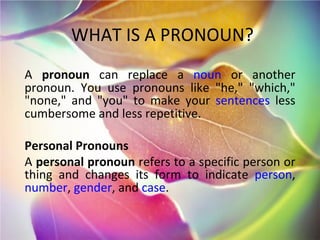What is a pronoun
- 1. WHAT IS A PRONOUN? A pronoun can replace a noun or another pronoun. You use pronouns like "he," "which," "none," and "you" to make your sentences less cumbersome and less repetitive. Personal Pronouns A personal pronoun refers to a specific person or thing and changes its form to indicate person , number , gender , and case .
- 2. Subjective Personal Pronouns A subjective personal pronoun indicates that the pronoun is acting as the subject of the sentence. The subjective personal pronouns are "I," "you," "she," "he," "it," "we," "you," "they.â Examples: We will meet at the library at 3:30 p.m. It is on the counter.
- 3. Objective Personal Pronouns An objective personal pronoun indicates that the pronoun is acting as an object of a verb , compound verb , preposition , or infinitive phrase . The objective personal pronouns are: "me," "you," "her," "him," "it," "us," "you," and "them." Example: Seamus stole the selkie's skin and forced her to live with him . Give the list to me .
- 4. Possessive Personal Pronouns A possessive pronoun indicates that the pronoun is acting as a marker of possession and defines who owns a particular object or person. The possessive personal pronouns are "mine," "yours," "hers," "his," "its," "ours," and "theirs." Note that possessive personal pronouns are very similar to possessive adjectives like "my," "her," and "their.â Examples: The smallest gift is mine . This is yours.
- 5. Demonstrative Pronouns A demonstrative pronoun points to and identifies a noun or a pronoun. "This" and "these" refer to things that are nearby either in space or in time, while "that" and "those" refer to things that are farther away in space or time. The demonstrative pronouns are "this," "that," "these," and "those." "This" and "that" are used to refer to singular nouns or noun phrases and "these" and "those" are used to refer to plural nouns and noun phrases. Examples: This must not continue. Three customers wanted these .
- 6. Interrogative Pronouns An interrogative pronoun is used to ask questions. The interrogative pronouns are "who," "whom," "which," "what" and the compounds formed with the suffix "ever" ("whoever," "whomever," "whichever," and "whatever"). Note that either "which" or "what" can also be used as an interrogative adjective , and that "who," "whom," or "which" can also be used as a relative pronoun. You will find "who," "whom," and occasionally "which" used to refer to people, and "which" and "what" used to refer to things and to animals. Examples: Which wants to see the dentist first? Whom do you think we should invite?
- 7. Indefinite Pronouns An indefinite pronoun is a pronoun referring to an identifiable but not specified person or thing. An indefinite pronoun conveys the idea of all, any, none, or some. The most common indefinite pronouns are "all," "another," "any," "anybody," "anyone," "anything," "each," "everybody," "everyone," "everything," "few," "many," "nobody," "none," "one," "several," "some," "somebody," and "someone." Note that some indefinite pronouns can also be used as indefinite adjectives . Example: Many were invited to the lunch but only twelve showed up.
- 8. Reflexive Pronouns You can use a reflexive pronoun to refer back to the subject of the clause or sentence. The reflexive pronouns are "myself," "yourself," "herself," "himself," "itself," "ourselves," "yourselves," and "themselves." Note each of these can also act as an intensive pronoun. Examples: Diabetics give themselves insulin shots several times a day. Richard usually remembered to send a copy of his e-mail to himself .
- 9. Intensive Pronouns An intensive pronoun is a pronoun used to emphasise its antecedent . Intensive pronouns are identical in form to reflexive pronouns. Examples: I myself believe that aliens should abduct my sister. The Prime Minister himself said that he would lower taxes.
- 10. THANKS









